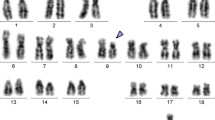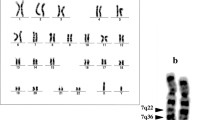Abstract
Biphenotypic acute leukemia co-expressing T-lymphoid and myeloid markers is rare, accounting for less than 1% of acute leukemias. However, several clinical characteristics including male predominance, frequent lymphadenopathy and unfavorable outcome have been identified. Recurrence of monosomies 7p and/or 12p in T/myeloid biphenotypic acute leukemia has been reported. We treated a patient with T/myeloid biphenotypic acute leukemia showing clonal chromosomal and genetic abnormalities including dic(7;12)(p11;p11) and Fms-like tyrosine kinase 3 (FLT3)-internal tandem duplication. Cytogenetic analysis of both bone marrow and lymph node cells disclosed that the patient’s lymph node leukemia cells had chromosomal abnormalities in addition to dic(7;12). Our findings suggest that the leukemia cells of systemic lymphadenopathy had evolved as secondary cells from marrow leukemia cells. The patient was successfully treated with induction chemotherapy for acute myeloid leukemia followed by allogeneic bone marrow transplantation.





Similar content being viewed by others
References
Jaffe ES, Harris NL, Stein H, Vardiman JW. World Health Organization classification of tumours. Pathology and genetics of tumours of haemapoietic and lymphoid tissues. Lyon: IARC press; 2001.
Bene MC, Castoldi G, Knapp W, et al. Proposals for the immunological classification of acute leukemias. European Group for the immunological characterization of leukemias (EGIL). Leukemia. 1995;9:1783–6.
Buccheri V, Matutes E, Dyer MJ, Catovsky D. Lineage commitment in biphenotypic acute leukemia. Leukemia. 1993;7:919–27.
Carbonell F, Swansbury J, Min T, et al. Cytogenetic findings in acute biphenotypic leukaemia. Leukemia. 1996;10:1283–7.
Matutes E, Morilla R, Farahat N, et al. Definition of acute biphenotypic leukemia. Haematologica. 1997;82:64–6.
Legrand O, Perrot JY, Simonin G, et al. Adult biphenotypic acute leukaemia: an entity with poor prognosis which is related to unfavourable cytogenetics and P-glycoprotein over-expression. Br J Haematol. 1998;100:147–55. doi:10.1046/j.1365-2141.1998.00523.x.
Przepiorka D, Weisdorf D, Martin P, et al. 1994 consensus conference on acute GVHD grading. Bone Marrow Transplant. 1995;15:825–8.
Washington K, Bentley RC, Green A, Olson J, Treem WR, Krigman HR. Gastric graft-versus-host disease: a blinded histologic study. Am J Surg Pathol. 1997;21:1037–46. doi:10.1097/00000478-199709000-00008.
Cruz-Correa M, Poonawala A, Abraham SC, et al. Endoscopic findings predict the histologic diagnosis in gastrointestinal graft-versus-host disease. Endoscopy. 2002;34:808–13. doi:10.1055/s-2002-34257.
Nakao M, Yokota S, Iwai T, et al. Internal tandem duplication of the flt3 gene found in acute myeloid leukemia. Leukemia. 1996;10:1911–8.
Rubio MT, Dhedin N, Boucheix C, et al. Adult T-biphenotypic acute leukaemia: clinical and biological features and outcome. Br J Haematol. 2003;123:842–9. doi:10.1046/j.1365-2141.2003.04715.x.
Killick S, Matutes E, Powles RL, et al. Outcome of biphenotypic acute leukemia. Haematologica. 1999;84:699–706.
Tiribelli M, Damiani D, Masolini P, Candoni A, Calistri E, Fanin R. Biological and clinical features of T-biphenotypic acute leukaemia: report from a single centre. Br J Haematol. 2004;125:814–5. doi:10.1111/j.1365-2141.2004.04969.x.
Owaidah TM, Al Beihany A, Iqbal MA, Elkum N, Roberts GT. Cytogenetics, molecular and ultrastructural characteristics of biphenotypic acute leukemia identified by the EGIL scoring system. Leukemia. 2006;20:620–6. doi:10.1038/sj.leu.2404128.
Nakao M, Janssen JW, Erz D, Seriu T, Bartram CR. Tandem duplication of the FLT3 gene in acute lymphoblastic leukemia: a marker for the monitoring of minimal residual disease. Leukemia. 2000;14:522–4. doi:10.1038/sj.leu.2401695.
Yamamoto T, Isomura M, Xu Y, et al. PTPN11, RAS and FLT3 mutations in childhood acute lymphoblastic leukemia. Leuk Res. 2006;30:1085–9. doi:10.1016/j.leukres.2006.02.004.
Xu F, Taki T, Yang HW, et al. Tandem duplication of the FLT3 gene is found in acute lymphoblastic leukaemia as well as acute myeloid leukaemia but not in myelodysplastic syndrome or juvenile chronic myelogenous leukaemia in children. Br J Haematol. 1999;105:155–62. doi:10.1111/j.1365-2141.1999.01284.x.
Horiike S, Yokota S, Nakao M, et al. Tandem duplications of the FLT3 receptor gene are associated with leukemic transformation of myelodysplasia. Leukemia. 1997;11:1442–6. doi:10.1038/sj.leu.2400770.
Lee JH, Min YH, Chung CW, et al. Prognostic implications of the immunophenotype in biphenotypic acute leukemia. Leuk Lymphoma. 2008;49:700–9. doi:10.1080/10428190701843247.
Gale RE, Hills R, Kottaridis PD, et al. No evidence that FLT3 status should be considered as an indicator for transplantation in acute myeloid leukemia (AML): an analysis of 1,135 patients, excluding acute promyelocytic leukemia, from the UK MRC AML10 and 12 trials. Blood. 2005;106:3658–65. doi:10.1182/blood-2005-03-1323.
Stirewalt DL, Kopecky KJ, Meshinchi S, et al. Size of FLT3 internal tandem duplication has prognostic significance in patients with acute myeloid leukemia. Blood. 2006;107:3724–6. doi:10.1182/blood-2005-08-3453.
Ponziani V, Gianfaldoni G, Mannelli F, et al. The size of duplication does not add to the prognostic significance of FLT3 internal tandem duplication in acute myeloid leukemia patients. Leukemia. 2006;20:2074–6. doi:10.1038/sj.leu.2404368.
Author information
Authors and Affiliations
Corresponding author
About this article
Cite this article
Matsumoto, Y., Taki, T., Fujimoto, Y. et al. Monosomies 7p and 12p and FLT3 internal tandem duplication: possible markers for diagnosis of T/myeloid biphenotypic acute leukemia and its clonal evolution. Int J Hematol 89, 352–358 (2009). https://doi.org/10.1007/s12185-009-0268-7
Received:
Revised:
Accepted:
Published:
Issue Date:
DOI: https://doi.org/10.1007/s12185-009-0268-7




